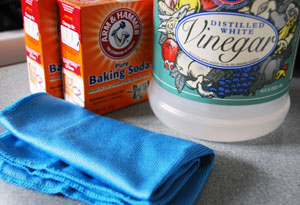I grew up in a house where my mom bragged you could eat off the floors. I, at one point, seemed to have inherited those same traits, once demonstrating to a boyfriend that my floors were clean enough to eat off of by licking them. Now, I find dust bunnies that rival the size of real ones and have acquired a pesky habit of holding on to stuff I no longer want or need. I’m determined to do things differently.
Don’t get me wrong. I am cluttered, but my place is pretty clean. It’s just clean in a different way than what I grew up with and many folks are used to. My parents’ house was wiped down with bleach and other harsh chemicals, while mine is cleaned with eco-friendly products.
We’ve been somewhat indoctrinated to think that the acrid smell of bleach is the smell of “clean,” but the chemical found in bleach (sodium hypochlorite) and other household products, including mildew remover and toilet cleaner, can burn our skin, cause a host of respiratory and gastrointestinal problems and may even be fatal.
My father, the most brilliant of scientists, will tell you that what matters are the amount, strength and method of exposure to household chemicals. He’s right. Sodium hypochlorite is used to purify our drinking water (which, to me, seems dreadful, and I wonder why we can’t just keep our water cleaner to begin with—but that’s for another post) and is a mighty powerful disinfectant. But what we must also consider are the toxic cocktails we’re whipping up when we mix bleach with, say, an ammonia-based cleaner. That causes the release of chloramines, generates hazardous fumes and is part of the reason the Environmental Protection Agency has found indoor air to be twice as polluted as outdoor air (a stat I have repeatedly recited).
Furthermore, we all have different tolerance levels. My sister is violently allergic to cats and pollen, while I can’t even really conceive of what an allergy looks or feels like. The Food and Drug Administration doesn’t require companies to divulge the contents of their products or the concentrations with which they are used. This means the most vulnerable among us are exposed to substances that sit on our floors and countertops, cling in our air and wash down our drains and toilets into our water supplies that might be really harmful. Just think about your pets or babies crawling around on floors cleaned with contents you aren’t sure of, then sticking their little hands and feet in their mouths.
The Household Product Labeling Act, introduced into the House of Representatives in summer 2009, would require that household cleaning products and similar products bear full and accurate ingredient labels so we can finally know everything in the products we use in our homes. Please contact your reps and let them know you support this effort.
This legislation is even more urgent now that a 2008 study published in Environmental Science & Technology by Dr. Mustafa Odabasi indicated for the first time that sodium hypochlorite and the cleaning agents (known as surfactants) and fragrances contained in several household cleaning products react within the product to create chlorinated volatile organic compounds (VOCs). The study says these chlorinated compounds are released when we clean, that most of them are toxic and probable carcinogens and that the indoor air concentrations increase anywhere from eight to 1,170 times during the use of products that contain bleach. The increase in chlorinated VOCs was lowest for plain bleach and highest for thick liquids and gels.
It’s absurd to think that all our efforts to be clean are actually making things dirty. Fortunately, it doesn’t have to be this way. I challenge you to redefine clean and seek out eco-friendly, nontoxic, phosphate-free cleaning products that reduce your exposure to toxins and limit the amount of poison released into our air, soil and water. The Environmental Working Group tested the umbilical cord blood of a random sampling of American babies and found an average of 200 chemicals transmitted in utero. You can just imagine what the chemical body burden of an average adult might be if babies start off so compromised.
Personally? I am a Seventh Generation junkie. They are a good company constantly trying to do better. They treat their staff well, care about where and how their materials are sourced (check out their new palm oil initiative), want their consumers to be informed and, most importantly, have products that work. Who wants to clean twice as hard to get half the results just to win a green star on behalf of the planet? Not many.
Seventh Generation paid me to moderate their chemical body burden and palm oil panels, but I would never accept money to endorse their products. I’ve used them for much longer than I’ve been in the public eye, and I am sharing their name here because I think the information is useful. I celebrate the companies that think about all aspects of their business. Seventh Generation embodies that for me. But they are not perfect. The last time I saw the CEO, I went on a mini-tirade about the chlorine-free feminine hygiene products that they mysteriously shroud in plastic!
Look at what you’re buying. Look at what your dollars are supporting. For me, it’s a disconnect to buy slightly cheaper green products from a company that makes most of its money making toxic ones. No one I know, except my mother and sister, cleans as well as I do. I hope one day to become one of those über-eco angels who whips up her own cleaning products out of baking soda, lemon juice and vinegar—because they are so much cheaper than anything on the market and really do make the whole house feel so much healthier.
Brewing my own cleaning products is one of my resolutions for 2011. For ideas on that and more, you can check out the incredibly comprehensive information on household cleaning products in the book Home Safe Home by Debra Lynn Dadd.
Simran Sethi is an award-winning journalist and associate professor at the University of Kansas School of Journalism and Mass Communications, where she currently teaches courses on sustainability and environmental communications and diversity in media. Simran is the contributing author of Ethical Markets: Growing the Green Economy, winner of the bronze 2008 Axiom Award for Best Business Ethics Book. She is also the founding host/writer of Sundance Channel’s environmental programming The Green and the creator of the Sundance online series The Good Fight, highlighting global environmental justice efforts and grassroots activism. Named one of the top ten eco-heroes of the planet by the UK’s Independent and lauded as the “environmental messenger” by Vanity Fair and “environmental woman of impact” by Daily Variety, Simran has contributed numerous segments to Nightly News with Brian Williams, CNBC, PBS, the Oprah Winfrey Show, and the Today Show; and appeared on MSNBC, the Ellen DeGeneres Show, Martha Stewart Show and History Channel. She is committed to a redefinition of environmentalism that includes voices from the prairie, the inner city and the global community.


HA! Scott F, thanks for being brave enough to say what I wasn’t about to.